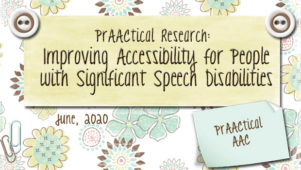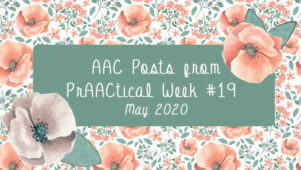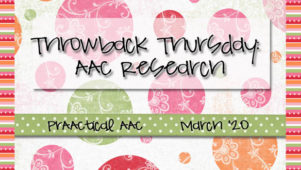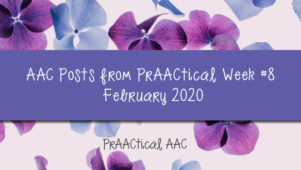A Fresh Look at AAC & Aphasia with Dr. Kristy Weissling
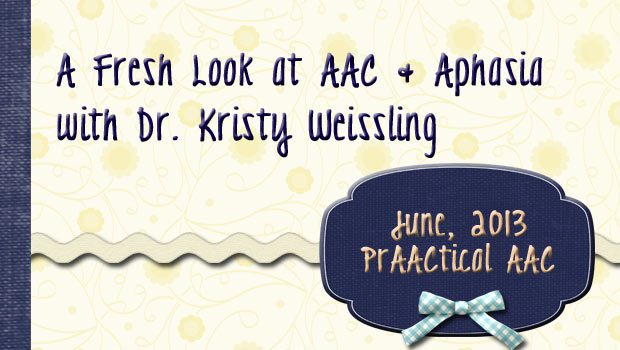
We’re so pleased to be able to share the thoughts of our friend and colleague, Dr. Kristy Weissling, on providing AAC supports to people with aphasia. She received her  professional doctorate from Nova Southeastern University and is currently an Assistant Professor of Practice and clinical supervisor at the Barkley Speech-Language and Hearing Clinic at the University of Nebraska-Lincoln. Her research and teaching interests include, aphasia, cognitive communication impairments, and AAC. She participates in implementation of a portion of the RERC grant project at the University of Nebraska-Lincoln. She has been an instructor in aphasia and cognitive linguistic impairments for 15 years and teaches in both online and live formats. Her clinical load includes individual and group treatment of individuals with aphasia, traumatic brain injury, and early cognitive decline. In this post, Kristy reflects on three articles that have shaped her clinical services and teaching.
professional doctorate from Nova Southeastern University and is currently an Assistant Professor of Practice and clinical supervisor at the Barkley Speech-Language and Hearing Clinic at the University of Nebraska-Lincoln. Her research and teaching interests include, aphasia, cognitive communication impairments, and AAC. She participates in implementation of a portion of the RERC grant project at the University of Nebraska-Lincoln. She has been an instructor in aphasia and cognitive linguistic impairments for 15 years and teaches in both online and live formats. Her clinical load includes individual and group treatment of individuals with aphasia, traumatic brain injury, and early cognitive decline. In this post, Kristy reflects on three articles that have shaped her clinical services and teaching.
::::::::::::::::::::::::::::::::::
I have been working with people who have aphasia for over 20 years. As a beginning clinician, I put a great deal of focus on recovery of speech-language skills. However, as I became more experienced, the idea of living with aphasia (Hinckley, 2006) became more important to my practice. I see AAC as a way to bridge the gap between where the person with aphasia is and where that person wants to be.
In the last 3 years, three articles have had a significant effect on my practice in aphasia and my passion for AAC interventions. The three articles all used qualitative research methods to answer big questions. Qualitative research uses observation and other techniques to look at the qualities of a group, individual, and/or problem. It is not an experimental design that results in a number that indicates significance. Rather, it is a way of analyzing data that relies on observation and inductive reasoning. The methodologies used in these articles of course have limitations. The power of the qualitative research to answer questions not answerable by numbers in these studies was robust. I have summarized some key points of the three articles below:
a) Susie Parr (Parr, 2007) completed a study using ethnography, a type of qualitative methodology. Ethnography, specifically, is a way to study a culture over a prolonged period of time by collecting observational and interview data (Cresswell, 2009). The results of this study indicated that social exclusion is a common experience in people with aphasia across a variety of care settings. She noted that the exclusion has 3 levels; infrastructure, interpersonal, and personal. Infrastructure exclusion included problems related to the lack of work available, financial strains, the need for appropriate housing, the need for services, the need for information that is adapted for the language needs of people with aphasia, training for caregivers, access to new technologies and information to use it, and assistance with travel. Interpersonal exclusion occurred as close relationships (e.g., previous friends, close neighbors) dwindled and social relationships became more common with service providers (e.g., therapists), and other people with aphasia seeking services. On the personal level, people with aphasia identified exclusion as they reported isolation, boredom, depression, a struggle with their new identity, and an overall lack of control. The author suggested that to change the experience of people with aphasia there needs to be support for their communication, an idea long discussed in the AAC literature. Additionally, she suggested an emphasis on acknowledgement and respect by caregivers through training in communication support and increased opportunity and access to infrastructure. While this was a small study (i.e., 20 people) and the participants in this study were in the United Kingdom, many of the same issues appear to apply to practice in the U.S. This study highlighted for me the significance of the problems faced by people with aphasia. The issues they face are so much more than decisions about which symbols to put on a communication system, or what vocabulary to include on a device. Living with aphasia is a complex undertaking . AAC is one piece of a larger puzzle for people with aphasia. Our goal should go beyond providing AAC and recovery from the problem. We need a larger lens with which to view how we can help people with aphasia reveal their potential and live successfully.
b) Jacqueline Hinckley (Hinckley, 2006), also used qualitative methods to evaluate published personal narratives authored or co-authored by a person/people living with aphasia. This article sought to identify what factors supported living successfully with aphasia. The author identified 4 main themes. Social support was identified as a key factor in living successfully with aphasia, as was, an adaptation of self, looking ahead and setting new goals, and taking charge of communication improvement. This article focused me more on qualities to look for in people with aphasia and what qualities to emphasize when working with people who have aphasia. The idea of taking responsibility for communication improvement, specifically resonated with me because of my work with evidence based practice. When I first began to explore evidence based practice I was amazed that it was much more than the external research. Dollaghan (2007) in her book on evidence-based practice puts an emphasis on the preferences of a well-informed patient one of three components the process (including the external research and internal support for the technique). The emphasis on patient preference in practice paired with the Hinckley and Parr articles had a profound impact on me. I was left with a startling insight. I should not be the final decider in what ultimately happens in patient care. While I had always considered the desires of people with aphasia and their AAC needs, I had not been systematic in assuring that their desires were implemented, even when it was not what I would have thought to do. That lead me to understand that sometimes it is the behavior (not using a device), not the agreement or disagreement with a strategy that communicated a patient’s true preferences. Today, I try to be systematic in including people with aphasia in decision making at every stage of the process, advising but leaving plenty of room for their ideas and desires. As I kept reading I began to see that my small world of treatment was much more complex than I had envisioned when I started out 20 years ago.
c) Finally, Linda Worrall and her colleagues (Worrall, et al., 2011) in Australia and New Zealand aptly titled their article, “What people with aphasia want: Their goals according to the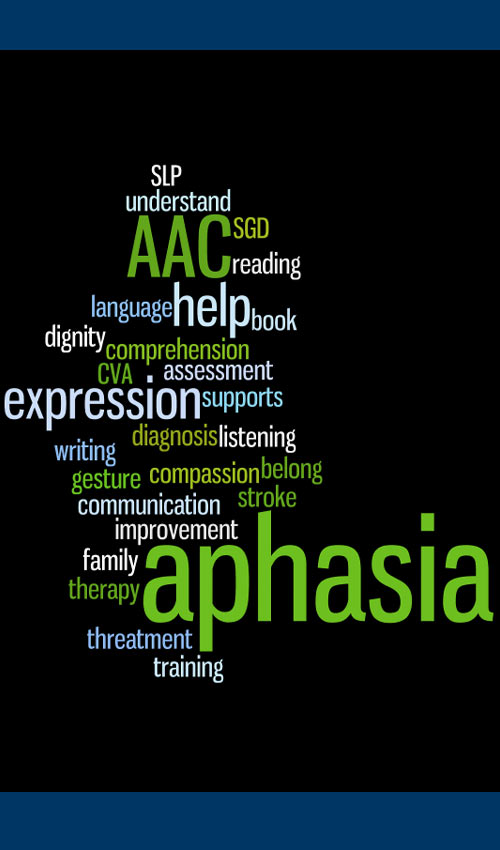 ICF.” The title alone was powerful. Here, Worrall and her colleagues used qualitative analysis to identify themes for the goals of people with aphasia. They identify 9 themes under which the participants’ goals for themselves fell. The authors then linked those themes to the International Classification of Functioning, Disability and Health (IFC) components (World Health Organisation (WHO), 2001). These nine categories of goals are discussed briefly below and will reiterate the findings of Parr (2007) and Hinckley (2006).
ICF.” The title alone was powerful. Here, Worrall and her colleagues used qualitative analysis to identify themes for the goals of people with aphasia. They identify 9 themes under which the participants’ goals for themselves fell. The authors then linked those themes to the International Classification of Functioning, Disability and Health (IFC) components (World Health Organisation (WHO), 2001). These nine categories of goals are discussed briefly below and will reiterate the findings of Parr (2007) and Hinckley (2006).
- Return to pre-stroke life. In this theme people with aphasia expressed, the desire to return to how they were before their stroke. Some people adjusted and this theme was less prevalent over time, for some people this remained a persistent theme.
- Communication. Every one of the people in the study expressed a desire to improve and recover communication function. They discussed the frustration, hopelessness, isolation, and depression that were associated with their lack of communication.
- Information. Many people reported that they had not received adequate information about their condition, specifically the term “aphasia.” While they may have been told and educated, their perception was that they had not. This certainly should cause clinicians to take pause and consider the information needs of people with aphasia.
- Speech therapy and other health services. The people in this study wanted speech therapy that met their needs throughout the recovery process. They wanted positive relationships with their therapists and indicated that they needed to understand how therapy was relevant to their life.
- 5. Control and independence. People with aphasia had a desire to be independent and do things on their own. Some wanted a larger role in decision-making and their care.
- Dignity and respect. People with aphasia in this study, like the Parr study, wanted to be acknowledged and respected.
- Social leisure, and work. Many people with aphasia had goals to be social and to participate in specific social activities.
- Altruism and contribution to society. Some people had goals to help others and to make specific improvements in the lives of others.
- Physical function and health. Many participants understood that their overall health and their physical health would dictate what they were able to achieve. For this reason, many of them had goals related to physical health (e.g., walking, managing diabetes).
Overall, this article (Worrall, et al., 2011) nicely summed up the areas within which people with aphasia formed their goals. While many had directly applicability to speech therapy and AAC others were focused on broader health issues.
So, what can we do with the information from these three articles? In my practice, they are now must-reads for students in my courses and in my clinic assignments. They caused me to take stock in the role of the expert in the process. They caused me to offer more choices and give more decision making power. It led me to check in more frequently with people regarding how therapy was meeting their needs. It caused me to listen more intently, to the aspirations of the people I worked with and to help them develop goals they wanted to achieve. I had very capable partners in the rehabilitation process – the people with aphasia I was working with. When we approach AAC we talk about today’s needs, tomorrow needs, and future needs. As we consider these, we must consider in the forefront, the goals of the people with aphasia with whom we are working. These articles changed my clinical practice. I’d suggest them to anyone who is ready to let people with aphasia take the lead in the rehabilitation process.
- Cresswell, J.W. (2008). Research design: Qualitative, Quantitative, and Mixed Methods Approaches (3rd Edition). SAGE Publications, Inc.
- Dollaghan, C. A. (2007). The handbook for evidence-based practice in communication disorders. Baltimore: Brookes.
- Kagan, A., Simmons-Mackie, N., Rowland, A., Huijbregts, Shumway, E. McEwen, S., Threats, T., & Sharp, S. (2008). Counting what counts: A framework for capturing real-life outcomes of aphasia intervention. Aphasiology, 22, 258-280.
- Hinckley, J. J. (2006). Finding messages in Bottles: Living successfully with stroke and aphasia. Topics in stroke rehabilitation13 (1), 25-36.
- Parr, S. (2007). Living with severe aphasia: Tracking social exclusion. Aphasiology, 21, 98–123.
- Worrall, L., Sheratt, S., Rogers, P., Howe, T., Hersh, D., Ferguson, A., & Davidson, B. (2011). What people with aphasia want: Their goals according to the ICF. Aphasiology 25, 309-322.
- World Health Organisation (WHO). (2001). International classification of functioning, disability and health (ICF). Geneva, Switzerland: World Health Organisation.
Filed under: PrAACtical Thinking
Tagged With: aphasia, EBP, Fresh Look, Kristy Weissling, research
This post was written by Carole Zangari

